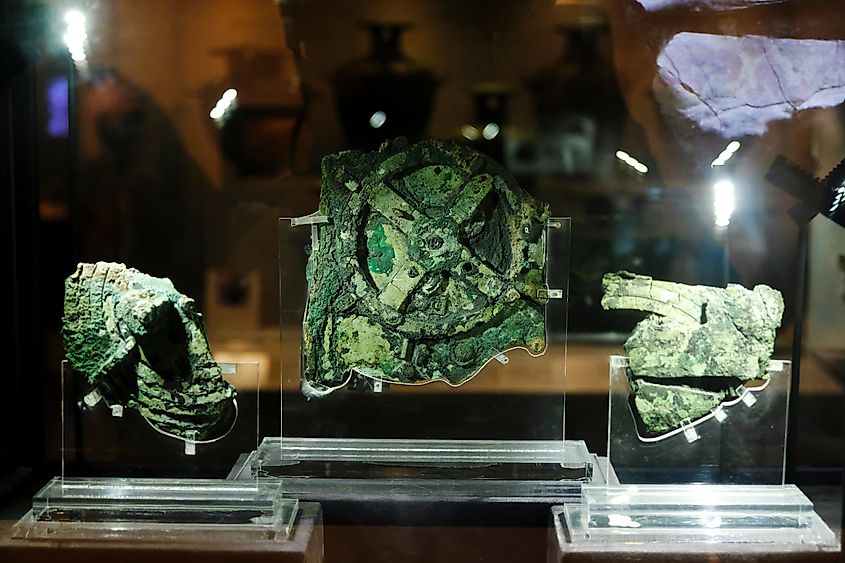
The Real History Behind The Archimedes Dial Featured In Indiana Jones
The last installment in the Indiana Jones movie series holds "The Dial of Destiny" at its core. Would you believe me if I told you it was a real thing? Well, The Dial of Destiny is, in fact, based on the Antikythera mechanism, a real device built by Ancient Greeks approximately 2150 years ago. The Antikythera mechanism had the first known set of scientific dials and is considered the first surviving geared analog computer in history. Despite not bending time as in the movie, this mysterious orrery holds the secrets to ancient views on astronomy and technology.
Indiana Jones And The Dial Of Destiny

Directed by James Mangold, the fifth and final chapter in the Indiana Jones saga is titled Indiana Jones and the Dial of Destiny, and it comes as a sequel to Indiana Jones and the Kingdom of the Crystal Skull. The adventure that Dr. Henry "Indiana" Jones, played by Harrison Ford, embarks on takes him to the elusive frontier of time itself. While time travel is slightly unrealistic, many elements of the fifth Indiana Jones film are rooted in reality.
By finding the titular Dial of Destiny, Indy and Helena get to learn about the history and be part of it. This mysterious "ancient hunk of gears" is based on the Antikythera mechanism. This artifact tracked by Indiana Jones is a device created during the Roman Empire era by Greek mathematician Archimedes. In reality, the Antikythera mechanism would not have been a disc as in the film, but rather a box covered in circles, and its origin might imply a connection with the school of Archimedes in Syracuse, but it is not clear if he took fathership of the Antikythera.
NASA And Nazis

The fantastic villain of Indiana Jones and the Dial of Destiny is Dr. Jürgen Voller, played by Mads Mikkelsen, a Nazi mathematician obsessed with the legendary Antikythera. In the Story, Voller was a defector to the United States and was recruited by NASA to help them in the "Space Race." Dr. Voller may be a fictional character, but it's a dark and open secret that NASA and the U.S. Government did recruit prominent Nazi figures in the mid-1940s.
Recruited under the U.S. initiative known as "Operation Paperclip," these scientists were not only dedicated to Adolf Hitler and the Nazi Party but also held positions as SS Officers and were possibly responsible for assisting with the notorious concentration camps. One of the most famous names recruited by NASA was Wernher von Braun, who perhaps is the main inspiration for Dr. Voller's character. W. von Braun is credited for pioneering the contemporary ballistic missile and other military innovations. Crafting a weapon of such magnitude leaves a stark legacy, yet this achievement pales in comparison to Wernher von Braun's deeply troubling involvement during World War II.
While much of this didn't come out until after his death, von Braun held a prominent position within the SS, and he is accused of personally selecting concentration camp prisoners to construct his lethal missiles, resulting in numerous fatalities among them. Ironically, the person hailed as the "father of space travel" is also one of history's most vile individuals. On the other hand, the fictional Dr. Jürgen Voller is obsessed with the Dial of Destiny for its time-bending properties that are obviously not rooted in reality.
The Antikythera Mechanism Discovery

The Antikythera Mechanism was first discovered in the Antikythera Island wreck in early 1900 by a crew of sponge divers from Symi Island captained by Dimitrios Kontos. This wreck was revealed to be a Roman cargo ship and was found at a depth of 148 feet. It was later recovered by the Hellenic Royal Navy in an expedition in 1901. The team retrieved multiple large objects, including marble and bronze statues, pottery, unique glassware, jewelry, coins, and the Antikythera device.
It is not known how the mechanism ended up on the cargo ship in the first place. To analyze and store these items, they were moved to the National Museum of Archaeology in Athens. The mechanism appeared to be a lump of rotten wood and corroded bronze, and it went unnoticed for two years! This lack of care resulted in deformational changes to the artifact. On 17 May 1902, archaeologist Valerios Stais uncovered a fragment of rock containing an embedded gear wheel. His initial interpretation leaned toward an astronomical clock, but many experts considered it to display a complexity seemingly beyond the capabilities of the era corresponding to the other fragments.
Albert Rehm, a German philologist, was the first to propose the idea that the Antikythera was an astronomical calculator, but the investigations into the object were suspended until it caught the interest of Yale Univerisity professor Derek J. de Solla Price in 1951. In 1971, J. de Solla Price and Greek nuclear physicist Charalampos Karakalos decided to make X-ray and gamma-ray scans of the 82 fragments. They published the images in a paper on their findings in 1974, highlighting the precision of this complicated instrument. The X-ray topography revealed approximately 3,500 letters and symbols, including the Sun, the Moon, the ecliptic, or the Zodiac Cycle, seemingly confirming the hypothesis of it being an astronomical calculator.
The Computer Ahead Of Its Time

Dated to more than 2,000 years ago, the device is deemed "probably the most exciting artifact that we have from the ancient world," according to Jo Marchant, the author of the 2008 book titled "Decoding the Heavens: Unraveling the Enigma of the Earliest Computer." The Antikythera Mechanism is an embodiment of high technology in antiquity, just like the Parthenon is the perfect example of Architecture. This device can easily be ranked among the Wonders of the Ancient World.
The Antikythera Mechanism was the first surviving geared analog computer in history. On the front face of the instrument, an immobile ring dial is present, representing the ecliptic. This dial features twelve zodiac signs, each marked off with equal 30-degree sectors. This matches with the Babylonian custom and impressively aligns with the variable boundaries of constellations. Surrounding this dial is another ring, which can be rotated and bears markings for the months and days in the Sothic Egyptian calendar. The months are labeled using the Egyptian month names transcribed into the Greek alphabet. Notably, the Egyptian calendar did not account for leap days, causing it to progress through an entire zodiac sign in approximately 120 years.
This fascinating instrument has a remarkable level of miniaturization and complexity of its parts. It has at least 30 gears, although expert Michael Wright suggests that the Greeks of that era were capable of implementing a system with many more gears. This ancient Greek astronomical calculating machine is considered the oldest known example of an analog computer and predicted eclipses based on the 223-lunar month Saros cycle decades in advance. It is also capable of predicting eclipses' characteristics, such as directions of obscuration, magnitude, color, and the angular diameter of the Moon. The device was not entirely accurate, but it was an astonishing achievement for its era.
This seemingly fantastic artifact belonging to science fiction has revealed itself to be an equally magical object, capable of predicting astronomical changes decades in advance and surprising experts. The Antikythera orrery has become famous for its intricate internal mechanism that some think is the root of modern computers. From the dark truth behind the movie's villain inspirations to the discovery of the device off the coast of the island of Antikythera to the complex hand-operated mechanism, showing impressive accuracy for its time, what was considered just a director's dream turned out to be an essential piece to the Human technology puzzle.











